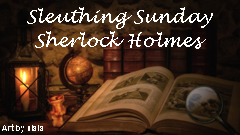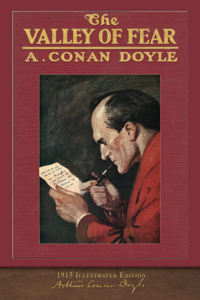Modern mystery readers are surprised by Arthur Conan Doyle’s structure for his first Sherlock Holmes novel, “A Study in Scarlet” (1887): We get the full puzzle and solution in the first half, then a flashback story in the second half explaining the victim’s and murderer’s relationship.
But readers at the time liked it, and Doyle repeats the formula in his fourth and final Holmes novel – although it set as the second novel in the chronology — “The Valley of Fear” (1915). I wonder if the author did this because he only mildly enjoyed writing Holmes; he was equally pulled toward other topics.
Another half-and-half novel
“Valley” is my favorite of the four novels for two reasons – one covering each half. First, it’s a step toward the Agatha Christie-popularized type of mystery fiction where the reader is let in on all the clues. We could theoretically figure this one out at the same time Holmes does.

“The Valley of Fear” (1915)
Author: Arthur Conan Doyle
Series: “Sherlock Holmes” No. 7 (the fourth novel)
Genre: Mystery
Settings: London, 1890s, with a flashback to decades earlier in America
Though not precisely a closed-room mystery, it’s almost in that vein. The patriarch of a manor – featuring an old-fashioned shallow moat and a drawbridge! – is found by his live-in friend in his study with his face smashed in.
Holmes, Watson and a couple of investigators interview the manor’s residents and servants. Of course, the official sleuths come to the conclusion they are meant to come to, whereas Holmes comes to the correct answer. It’s a good one, though you might kick yourself for not figuring it out.
The second half of “Valley of Fear” chronicles the titular area of American coal mines and shanty towns under the control of the Scowrers, a mob/union run by a domineering leader. A more run-of-the-mill criminal, McMurdo, then becomes our protagonist as he moves from Chicago to the valley looking for work. It’s not pleasant, but he soon joins the local branch of the Freemen fraternity known as the Scowrers.
Doyle gets hardboiled?
I’m impressed with how “Valley” is a British-written preview of the most American of hardboiled crime novels, Dashiell Hammett’s “Red Harvest” (1929). Doyle’s work seems to get less hype in the subgenre of an outsider cleaning up a corrupt town, perhaps because … (SPOILERS FOLLOW) … it’s a surprise, and a delicious one, to learn that McMurdo is himself the Pinkerton agent he had warned the mob boss about. (END OF SPOILERS.)
While not as briskly violent as “Red Harvest,” wherein the Continental Op strategically pits criminals against each other with the end goal of killing or jailing them all, Doyle does provide a sense of America’s “wild west” – although not in geographic sense, as these coal mines are presumably in the Appalachians.
This contrasts with the formality of Britain’s procedures, where Holmes slots in. Even if he doesn’t work directly with the police, Holmes seems to like the culture’s pace of life wherein he can smoke a pipe while mulling a case, and where urgency is only invoked when it’s warranted.
It’s possible Doyle brought this specific type of corruption to the attention of many readers. So “Valley” is a step toward both Christie – with the play-along nature of the clues – and Hammett – with the mob-controlled corners of a “free” country.
But meanwhile, this structure – wherein one genre (manor-house mystery) leads into another (a deep probe into organized crime) – didn’t remain popular. As noted, some readers today are put off by it, especially if they don’t enjoy the second genre. I have to admit that, as with “Study in Scarlet,” when I’m thrown from a cozy intellectual environment into a dirtier, lawless one, it leaves me off-balance. And frankly, I miss Holmes and Watson.
More Moriarty hints
Also of note about “Valley”: Doyle works to build up the Moriarty mythology. The novel takes place early in the timeline, so Holmes and Moriarty haven’t met, let alone grappled to the death over a waterfall. As with “The Final Problem,” Doyle’s interest in painting Moriarty as the mastermind of London’s criminal underground outpaces anything that’s actually on the page.
At first, I thought this might be a robust Moriarty story, but even 28 years into Doyle’s Holmes writings, readers still hadn’t gotten one! At least not one that details Moriarty’s network, schemes and psychological reasoning. Doyle is still merely teasing the Big Bad as a workaday professor with a dark side.
Well, even if “The Valley of Fear” is a minor advancement in Holmesian mythology, it’s a big advancement in showcasing the possibilities of the mystery genre.
Sleuthing Sunday reviews the works of Agatha Christie, along with other new and old classics of the mystery genre.


